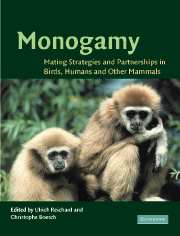Book contents
- Frontmatter
- Contents
- List of contributors
- Acknowledgements
- Introduction
- PART I Evolution of social monogamy
- PART II Reproductive strategies of socially monogamous males and females
- PART III Reproductive strategies of human and non-human primates
- CHAPTER 11 Ecological and social complexities in human monogamy
- CHAPTER 12 Social monogamy in a human society: marriage and reproductive success among the Dogon
- CHAPTER 13 Social monogamy in gibbons: the male perspective
- CHAPTER 14 Pair living and mating strategies in the fat-tailed dwarf lemur (Cheirogaleus medius)
- CHAPTER 15 Social monogamy and its variations in callitrichids: do these relate to the costs of infant care?
- CHAPTER 16 Monogamy in New World primates: what can patterns of olfactory communication tell us?
- Index
CHAPTER 14 - Pair living and mating strategies in the fat-tailed dwarf lemur (Cheirogaleus medius)
Published online by Cambridge University Press: 05 July 2014
- Frontmatter
- Contents
- List of contributors
- Acknowledgements
- Introduction
- PART I Evolution of social monogamy
- PART II Reproductive strategies of socially monogamous males and females
- PART III Reproductive strategies of human and non-human primates
- CHAPTER 11 Ecological and social complexities in human monogamy
- CHAPTER 12 Social monogamy in a human society: marriage and reproductive success among the Dogon
- CHAPTER 13 Social monogamy in gibbons: the male perspective
- CHAPTER 14 Pair living and mating strategies in the fat-tailed dwarf lemur (Cheirogaleus medius)
- CHAPTER 15 Social monogamy and its variations in callitrichids: do these relate to the costs of infant care?
- CHAPTER 16 Monogamy in New World primates: what can patterns of olfactory communication tell us?
- Index
Summary
INTRODUCTION
Primates show a great diversity in their social organizations and mating systems (ranging from single pair bonds to multi-male/multi-female groups), including monogamy, polygyny, and promiscuity (Smuts et al., 1987; Jolly, 1995; Kappeler, 1997; Müller & Thalmann, 2000). Social monogamy is assumed to occur in 15% of all primate species (Kleiman, 1977; Rutberg, 1983; Wright, 1990; Müller & Thalmann, 2000). And even though male care in primates is often associated with pair living, the participation of the male is assumed to be the consequence and not the cause of pair living (Dunbar, 1995; Komers & Brotherton, 1997; Brotherton & Komers, chapter 3; van Schaik & Kappeler, chapter 4). To understand the evolution of monogamy in a certain species, information about cost:benefit ratios of reproductive strategies is necessary. In terms of individual reproductive output, molecular genetic methods are powerful tools for estimating potential costs and fitness benefits associated with different mating strategies (Hughes, 1998). Sociobiological models suggest that sociogenetic monogamy occurs only if fitness benefits (i.e., future reproduction of offspring) can compensate for the costs of missed additional matings (Hamilton, 1967; Trivers, 1985; Mock & Fujioka, 1990; Maynard Smith, 1991). However, paternity analyses, especially in bird species, have revealed that living with a permanent partner does not necessarily imply renunciation of additional matings with extra-pair mates, and that social monogamy masks a diverse range of genetic mating systems (Mock & Fujioka, 1990; Birkhead & Møller, 1992; Stutchbury & Morton, 1995; Reynolds, 1996; Hughes, 1998).
- Type
- Chapter
- Information
- MonogamyMating Strategies and Partnerships in Birds, Humans and Other Mammals, pp. 214 - 231Publisher: Cambridge University PressPrint publication year: 2003
- 6
- Cited by



